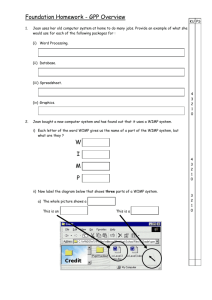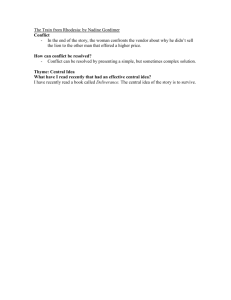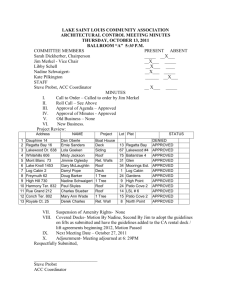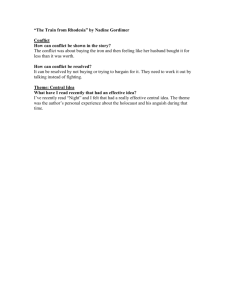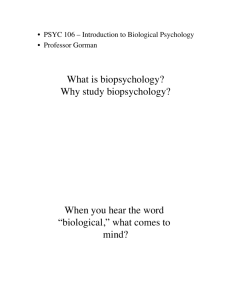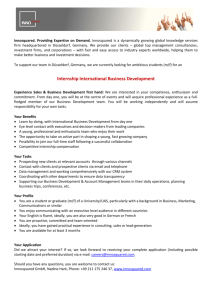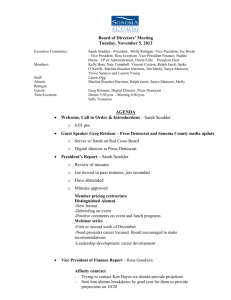BendigoEducationPlanPowerPoint
advertisement
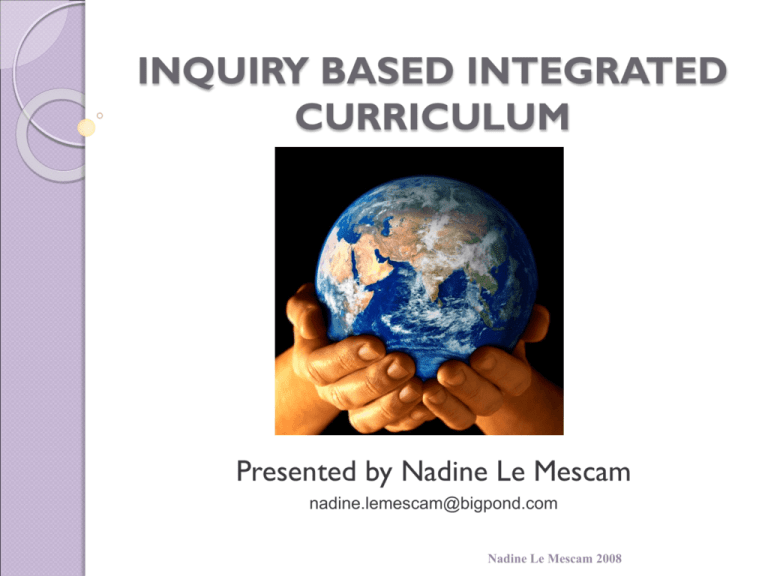
INQUIRY BASED INTEGRATED CURRICULUM Presented by Nadine Le Mescam nadine.lemescam@bigpond.com Nadine Le Mescam 2008 Wanted: Global Citizens The world needs young people who are culturally sophisticated and prepared to work in an international environment To do this, schools need to restructure curriculum and pedagogy to place student engagement at the centre of learning Learning should be based on key concepts and issues relevant to students lives Education for a global era is education for lifelong cognitive and behavioral engagement with the world (Suarez-Orozco and Sattin, 2007) Nadine Le Mescam 2008 How? What we know.... We should try and turn out people who love learning so much and learn so well that they will be able to learn whatever needs to be learned (John Holt) Learning should have horizontal relevance, mere vertical relevance isn’t enough (Lilian Katz, Alfie Kohn) Students learn most avidly and have their best ideas when they get to choose which questions to explore (Alfie Kohn) Nadine Le Mescam 2008 WHAT IS “ESSENTIAL”? Nadine Le Mescam 2008 What is essential for your learning community? Bendigo Education Plan Personalised Learning Negotiated Curriculum Transdisciplinary Learning Inquiry Based Nadine Le Mescam 2008 VELS Perspectives To succeed in our ever-changing world, students need to develop the capacities to: Manage themselves as individuals and in relation to others Understand the world in which they live; and Act effectively in that world Nadine Le Mescam 2008 Victorian Essential Learning Standards Manage self and relationships Understand their world Act effectively UNESCO Four Pillars of Learning Learning to Know Learning to Do Learning to Be Learning to Live Together Nadine Le Mescam 2008 ACCORDING TO VELS.... The standards for student achievement do not prescribe any particular curriculum. Nor do they constitute the totality of the program that students will receive. Rather, they indicate what is essential for students to know and be able to do at different levels. It is then up to schools and teachers to choose the curriculum that best helps students to meet these standards, while addressing broader student interests and needs . Nadine Le Mescam 2008 AT THE HEART OF IT.... The essence of the Victorian Essential Learning Standards is the integrated focus on knowledge, skills and behaviours in the three strands of Physical, Personal and Social Learning, Discipline-based Learning, and Interdisciplinary Learning that together develop deep understanding in learners which can be transferred to new and different contexts. Nadine Le Mescam 2008 WHAT DO TEACHERS SAY? When planning with the Victorian Essential Learning Standards (VELS), many teachers are discovering the value of inquiry to purposefully integrate domains from each of the strands. Murdoch, 2006 Nadine Le Mescam 2008 INTEGRATED CURRICULUM Nadine Le Mescam 2008 Integrated Curriculum Structured organisation of teaching and learning experiences Significant content to develop understandings of the world Authentic links occur across and within learning areas Nadine Le Mescam 2008 A common stumbling block…. Nadine Le Mescam 2008 Our Working Model “In essence, integrating the curriculum involves the integration of content and process. The content subjects are essentially concerned with ideas about how the world works. The process subjects offer a range of ways of allowing us to represent how we see and make meaning of our world (real or imagined).” Pigdon and Woolley, 1992, p.7 Nadine Le Mescam 2008 The content subjects are essentially concerned with ideas about how the world works. The process subjects offer a range of ways of allowing us to represent how we see and make meaning of our world (real or imagined) Murdoch, 1998, p.3 Nadine Le Mescam 2008 SIGNIFICANT CONTENT AREAS: Those areas which contain understandings about how the world works Host Areas of Inquiries Civics and Citizenship The Humanities (Economics, Geography, History) Science Health and Physical Education (Health Knowledge and Promotion) The Arts English Communication Mathematics Health and Physical Education (Movement and Physical Activity) LOTE Design, Creativity and Technology ICT PROCESS AREAS: Those areas which allow us to find out or sort our information about how the world works They helps use perceive the world, or express what we know and/or feel. Nadine Le Mescam 2008 Interpersonal Development Personal Learning Thinking LEARNING SKILLS AREAS: Those areas which contain the skills of inquiry These are the ways that we work as we inquire These are ongoing throughout any inquiry, and are developed in context of the learning environment Integrating the Curriculum •Structured organisation of teaching and learning experiences •Significant content to develop understandings of the world ENGLISH Civics and Citizenship ICT •Authentic links occur across and within learning areas Interpersonal Learning Nadine Le Mescam 2008 Relationship Between Content and Process CONTENT Give substance and meaning to forms of perception and expression Nadine Le Mescam 2008 PROCESS In turn, forms of expression and perception enable us to make sense of life experience Integrated curriculum is best delivered…. Within an inquiry based approach: “Learning is more powerful when content, process and skills are developed and extended in meaningful, integrated contexts where students construct their own learning” Wilson & Wing Jan, 2003, p.11 Nadine Le Mescam 2008 INQUIRY LEARNING Nadine Le Mescam 2008 Understanding starts with a question, not any question, but a real question. (Bettencort, 1991) Discuss with your group: What does this mean to you? Nadine Le Mescam 2008 A real question expresses the desire to understand. This desire is what moves the questioner to pursue the question until an answer has been made. Desiring to understand opens ourselves to experiencing what is new as new, and the already known under new aspects. (Bettencort, 1991) Nadine Le Mescam 2008 Real questions come from students Students are more likely to be engaged when they focus on answering their own questions (Oehelkers & Ruple, 2007) Inquiry questions can’t be framed ahead of time by teachers or curriculum experts....the questions and curriculum, are negotiated with the students. (Short & Burke, 1996) Nadine Le Mescam 2008 INQUIRY BASED LEARNING Learning is not just about content, but also process. An effective integrated curriculum should consider connections, but also the way in which students learn. Inquiry learning is a process of investigation Questions are formed, and time is given to explore the answers Allows students to unify, rather than separate, knowledge as they move from acquisition of facts to the development of broader concept and generalisations Nadine Le Mescam 2008 THEORY BUILDING GENERALISATIONS: Expressions of the relationship between two or more concepts THE RELATIONSHIP BETWEEN FACTS, CONCEPTS, AND GENERALISATIONS Adapted from Wilson and Wing Jan, 2003, p.4 CONCEPTS: Classified/categorised groups of related facts FACTS: Truths about specific events, objects, people. These are easily investigated Nadine Le Mescam 2008 The Inquiry Process 1. 2. Arrange in the learning process What happens at each stage? Nadine Le Mescam 2008 TUNING IN FINDING OUT SORTING OUT GOING FURTHER ACTION DRAWING CONCLUSIONS THE INQUIRY PROCESS Nadine Le Mescam 2008 TWO LAYERS TO INQUIRY LEARNING Inquiry learning can be used to as a vehicle to plan and drive effective integrated units of work. Through learning to learn and reflection on the learning process, students can become active members of the learning community by undertaking their own personal inquiries either within the topic, or in a topic of their own choice. The result is powerful learning with active engagement through investigating, processing, organising, synthesizing, refining and extending their knowledge within a topic Nadine Le Mescam 2008 Although specific definitions of inquiry vary, key features centre on it being an active, student centered learning process whereby questions are formed and time is given to seek answers. (Wilson & Wing Jan, 2003). Nadine Le Mescam 2008 Active learning is not just about doing things; it about students actively thinking. A task that sends students off to the internet to do a bit of ‘Googling’ and stitch the results together is not a task that is encouraging active thinking and questioning. (Hutchings, 2008) Nadine Le Mescam 2008 INQUIRY BASED INTEGRATED CURRICULUM Nadine Le Mescam 2008 Features The sequence follows the inquiry process. Begins with students prior knowledge, perceptions and understandings Activities are based around ,moving, extending, developing these Students and teacher draw on a range of resources and work across domains and dimensions Nadine Le Mescam 2008 It’s not step by step..... Inquiry is not a "method" of doing science, history, or any other subject, in which the obligatory first stage in a fixed, linear sequence is that of students each formulating questions to investigate. Rather, it is an approach to the chosen themes and topics in which the posing of real questions is positively encouraged, whenever they occur and by whoever they are asked. Equally important as the hallmark of an inquiry approach is that all tentative answers are taken seriously and are investigated as rigorously as the circumstances permit. (Wells, 2001) Nadine Le Mescam 2008 GENERATIVE TOPICS UNDERSTANDING GOALS Big Ideas or important broad knowledge students will develop during the unit (May link with Throughlines) PERFORMANCES OF UNDERSTANDING Activities and experiences developed using/following the inquiry approach Significant Content relating to and extending students’ life experiences and understandings about the world Adapted from: The Teaching for Understanding Framework (Blythe and Associates, 1998) ONGOING ASSESSMENT Essential in providing both cumulative and summative data. For students, teachers and learning community Nadine Le Mescam 2008 Passionate and Purposeful Inquiries need to go beyond ‘doing’ a topic They need to be investigations with real purpose Investigate questions that link to universal concepts: How does a healthy garden grow? Links to: change, interdependence, cycles. Also skills of teamwork and value of responsibility Murdoch, 2006 Nadine Le Mescam 2008 This has been happening....what we are seeing... Murdoch, 2004 Nadine Le Mescam 2008 Planning for Inquiry Significant content: Framed around provocative, essential questions rather than closed ‘topics’. What is the difference? Natural Disasters vs How does the Earth work? Nadine Le Mescam 2008 Generative Topics Central to one or more domains Interesting to students (Varies according to age, social and cultural contexts, personal interests, and intellectual experiences of students) Interesting to the teacher Are accessible Offer opportunities for multiple connections Have an inexhaustible quality Blythe and Associate, 1998 Nadine Le Mescam 2008 What do they look like? Questions: What does science mean to us? Why war? What are the challenges and choices we face in our lives? Statements: Look after Number 1: How can we care for our bodies? Why do people harm their bodies? Making life easier: How has technology changed our lives? Does it make life easier? The message in the medium: How do we communicate? How do our messages vary according to medium? Nadine Le Mescam 2008 Inquiry needs to be... ...built on key concepts grounded in events and issues relevant to students‘ lives. For example, assignments can encourage students to think about certain everyday activities—the food they consume or the clothing they purchase—in such a way that they begin to identify how their actions are embedded in a larger global context and have widespread implications. Assignments like this can help make the global local for students. (Suarez-Orozco & Sattin, 2007) Nadine Le Mescam 2008 What is different? Inquiry involves a shift in our thinking as teachers Instead of using a theme as an excuse to teach science, mathematics or reading, these become tools for exploring knowledge about how the world works and for researching students own questions The major focus is the inquiry itself, not the content area distinctions (Short and Burke, 1996) Nadine Le Mescam 2008 The Primary Focus of Inquiry Your aim is to prepare students to undertake their inquiry, by providing key shared experiences and developing their skills within context. They are then able to formulate questions and seek understanding with yours and others help. Nadine Le Mescam 2008 Imagine.... Trying to learn how to drive from a book or from lectures from someone else You study diagrams such as the position of the brake and accelerator You read about processes of releasing the clutch as the accelerator is depressed You memorize appropriate braking distances Would you pass the driving test? (Blythe & Associates, 1998) TYPES OF INQUIRY Discuss the table: Can you think of examples for each? What have you seen or experienced? Look at the samples of planners: What types of inquiries are these? Nadine Le Mescam 2008 How does Animation work? WHAT TYPE OF INQUIRY LEARNING IS THIS? Essential question: Came from a conversation in the classroom Understandings came from the students: What do you want to know/understand? Nadine Le Mescam 2008 NEGOTIATING THE CURRICULUM What are our thoughts? What do we mean by ‘negotiated curriculum?’ Why is it worth pursuing? What can it look like in action? What needs to be in place for negotiated curriculum to really ‘work’? Definitions of negotiated curriculum are many and varied…but generally share common themes “Negotiating the curriculum means classrooms in which teachers invite and allow students to help construct the learning journey” Boomer 1992: 277 “Students develop their own curriculum, study methods and assessment - built around questions and issues that are important to them” James Beane Common elements include... Builds trust and shared decision making Managing self and self in relation to others Values the learner and their interests Level of negotiation is varied There is a difference between negotiating the curriculum, and choosing between pre-determined choices Why? If we own our learning - we learn more effectively When we own our learning - we learn how to learn True negotiation creates a stronger, more committed community of learners A true community of learners is so much easier to ‘manage’! We can attend more effectively to individual needs and strengths Reasonable limits “Absolute freedom”: Every influential proponent of negotiated curriculum acknowledges there are limits on what can be negotiated. Age should not always restrict choice/voice: This prevents younger children from making choices well within their capacities. It can set up a vicious circle if you wait: “It is experience with decisions that help children become capable of handling them” (Kohn, 1993). Structures, modelling, scaffolding, MUST HAPPEN. The crucial difference between structures and limits, and control and coercion has gone unrecognized. Pseudochoice..... Offering a choice that is ‘loaded’ (Finish or you will stay in at recess) Let them think the are having a say in a decision that is already made Choose from predetermined choices and tasks designed by the teacher A Ladder of Citizen Participation: by Sherry R Arnstein Increased degrees of decision making. Enables them to negotiate with power-holders, leading to them having managerial power at the top rung. Allow to ‘have nots’ to hear and have a voice, however the power holders still decide. Designed to ‘educate’ or ‘cure’ by a greater power Use the work samples in the pack: Where do they sit on the ladder? From Learner Voice Handbook: by Futurelab Positive effects include General well being: Sense of control Behaviour and values: Responsibility, not just authority and power Academic achievement: Motivation and engagement Teachers: More interesting and rewarding Intrinsic Value: Democratic learning communities What we find.... Students are rarely invited to become active participants in their own education. Schooling is typically doing things to children, not working with them. Kohn, 1993 Why is this the case? Grammar of Schooling: teacher and student roles, curriculum Sharing the power Keeping track Having a go “If people are given the given the skills and tools to use, and presented with a range of potentially powerful educative experiences, then given freedom, they will almost invariably choose one and get on with it. Once learners get in touch with their own sense of personal power, get out of their way and watch in awe” Edwards 2004: encouraging achievement: 3 “The things we steal from children” (Edwards, 2000) If I am always the one to think of where to go next, how will they ever know where to begin? If I am the one who is always monitoring progress, how will they learn to continue their own work? If all the marking and editing is done by me, how will they find ownership, direction and delight in what they do? If I speak of individuals but present learning as if they are all the same, how will they get to know themselves as thinkers? For if they: Have never experienced being challenged in a safe environment Have had all of their creative thoughts explained away Are unaware what catches their interest and how then to have confidence in their interest Have never followed anything they are passionate about to a satisfying conclusion Have not clarified the way they sabotage their own learning Are afraid to seek help and do not know who to ask Have not experienced overcoming their own inertia Are paralyzed by the need to know everything before writing or acting Have never got bogged down Have never failed Have always played it safe HOW WILL THEY EVER KNOW WHO THEY ARE? Some useful references Beane, J. (1991). ‘The Middle School: The Natural Home of Integrated Curriculum’, Educational Leadership, 49(2), 9-13. Beane, J. (1992). Integrated Curriculum in the Middle School, ERIC Digest, 2-3, ED 351095. Boomer, G., Lester, N., Onore, C., & Cook, J. (eds.), (1992). Negotiating the Curriculum: Educating for the 21st Century, USA: The Falmer Press. DEET. (2002). Middle Years Research and Development (MYRAD) Project Executive Summary, A report to the Learning and Teaching Innovation Division DEET by the Centre of Applied Educational Research Faculty of Education The University of Melbourne, February-December 2001. Murdoch, K. (1998). Classroom Connection: Strategies for Integrated Learning, Australia: Eleanor Curtain. Murdoch,K. and Wilson, J.(2004) Learning Links: strategic teaching for the learner centred classroom. Curric Corp. Coloroso, B. (2002) Kids are worth it! Quill NY Brooks, J. and Brooks,M. (1999) The case for constructivist classrooms. ASCD VA Otero, G. et al: (2001) Relational learning : education for mind body, spirit. Hawker Brownlow Edwards, J: the Things we steal from Children: www.eddept.wa.edu/gifttal/EAGER/Dr%20 Edwards.html
